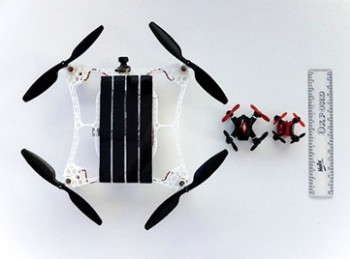News
Queen Mary researcher develops the world's smallest solar multirotor drone
Centre for Advanced Robotics3 July 2024
Dr Hasan Shaheed has developed the drone which has a dimension of only 0.15m × 0.15m and a weight of 0.071kg.
The work has been published in Nature's Scientific Reports and PV Magazine, the leading global solar and storage media platform.
The article, 'Development of a solar powered multirotor micro aerial vehicle' explains how the Micro Solarcopter, is a rechargeable radio-controlled aircraft with an average flight time of 3.5 minutes. It recharges in approximately 68 minutes under standard test conditions (1000 W/m2 and 25oC) and can hibernate for 38 days without sunlight.
As the system can recharge independently, it is not required to be tethered to a home base, allowing it to remain out in the field during a mission, potentially making it more autonomous.
As a Micro Aerial Vehicle (MAV), it offers many advantages compared to larger systems, including low-altitude flight capability and reduced costs. It generates energy using a solar panel, and has more autonomy and is more agile for specific low-level flying applications compared to fixed-wing setups.
The Micro Solarcopter is fitted with a first-person view (FPV) camera, making it suitable for wide-ranging applications, including continuous monitoring of environmental conditions and video inspection of an object or area of interest. It even has potential for exploration of other planets such as Mars, where charging stations are unavailable. The small size makes the system suitable for swarm configurations, an effective multi-MAV system, to cover a wide area of interest in flight and execute a variety of tasks in parallel.
Watch a video of a test flight below, demonstrating its external camera and its First Person View camera.
Email: m.h.shaheed@qmul.ac.uk
Updated by: David Lockwood






